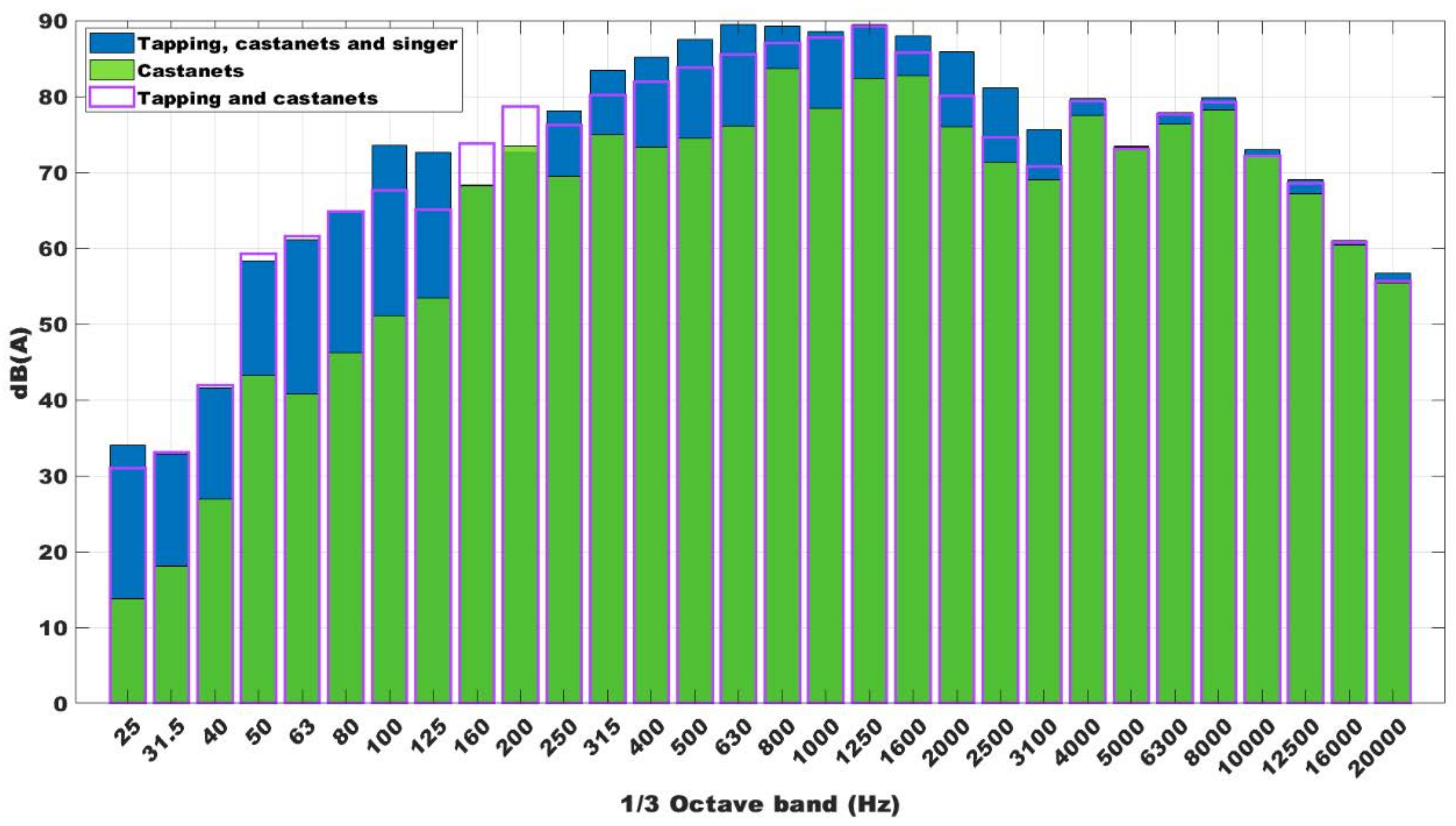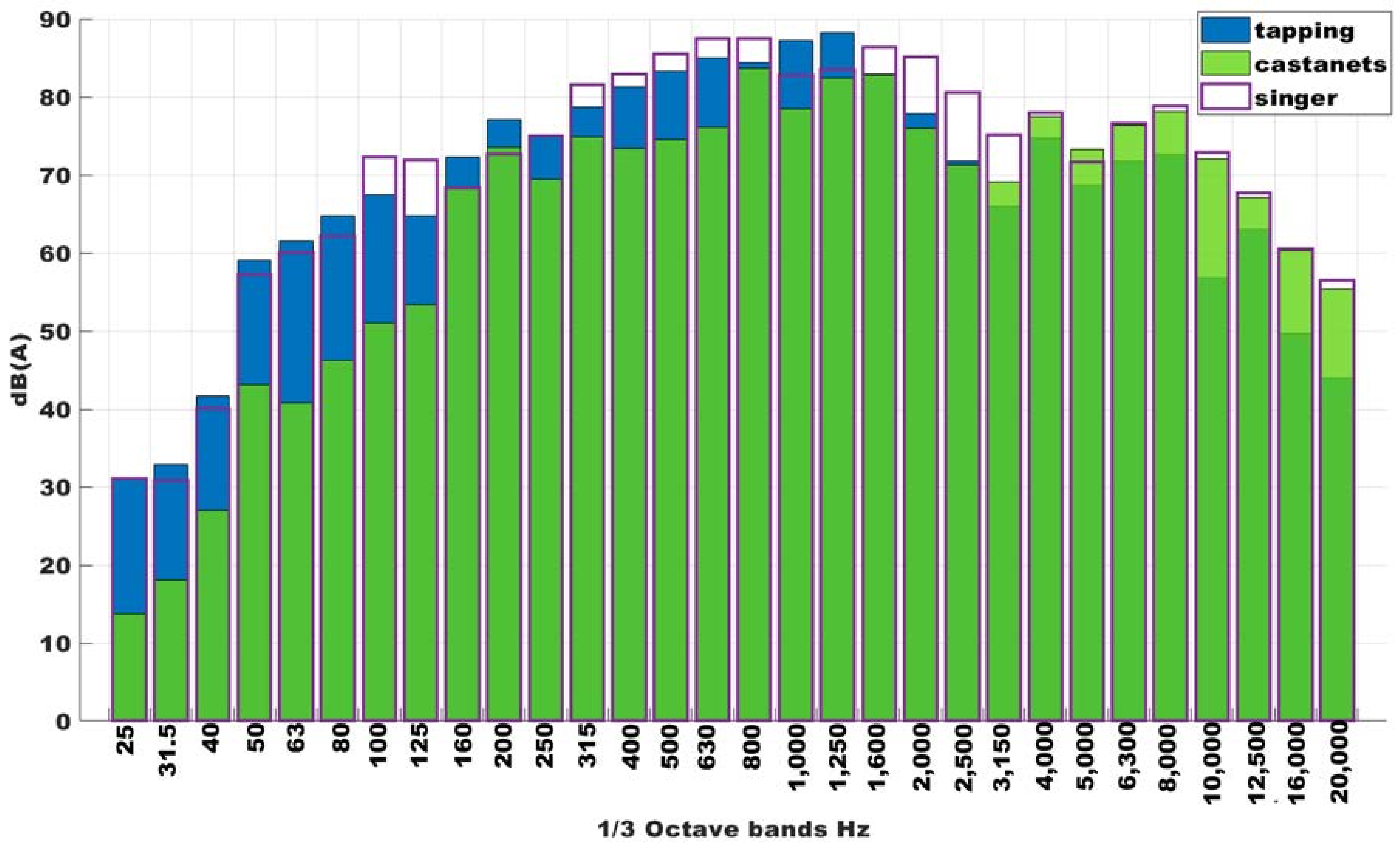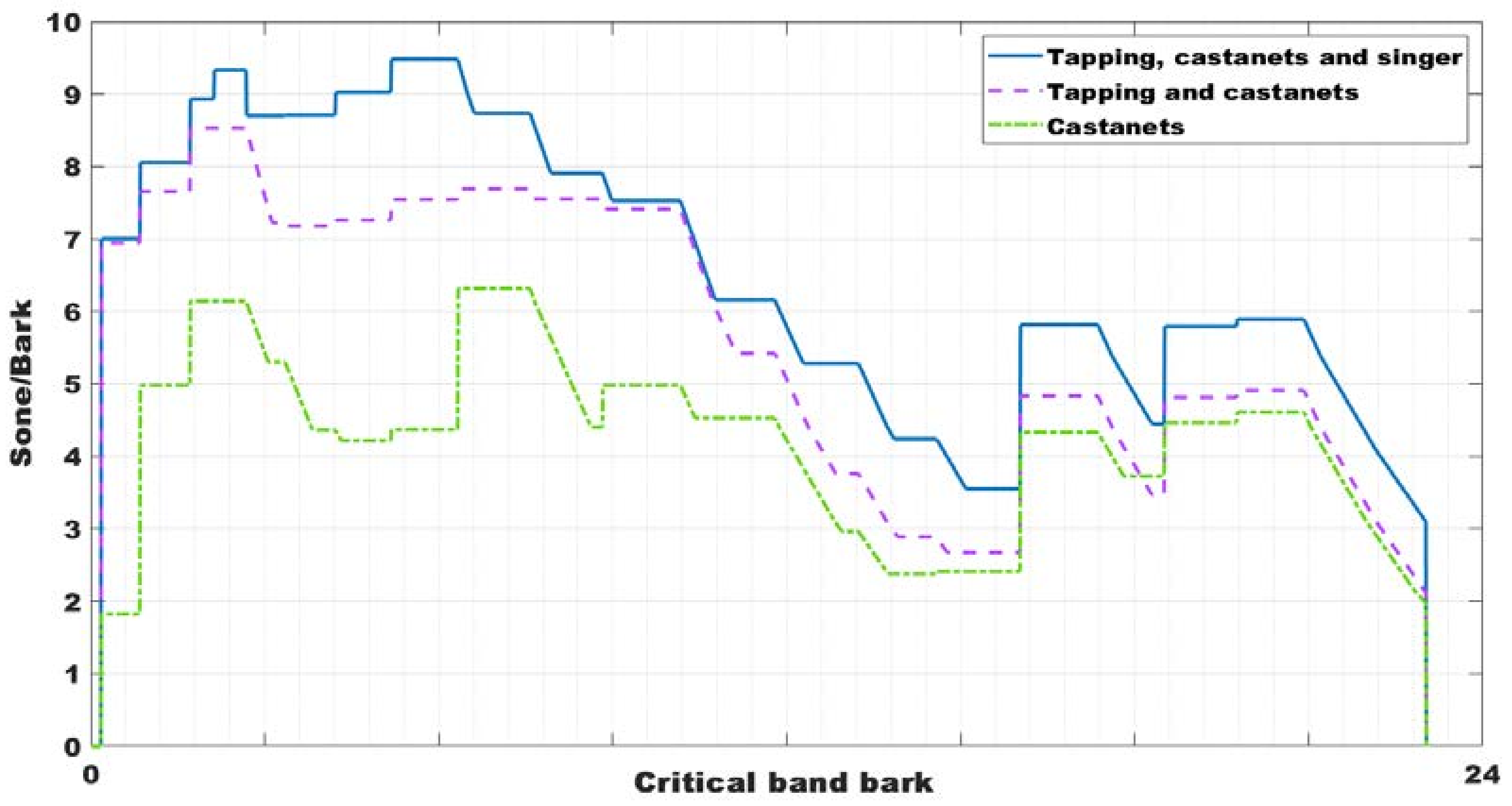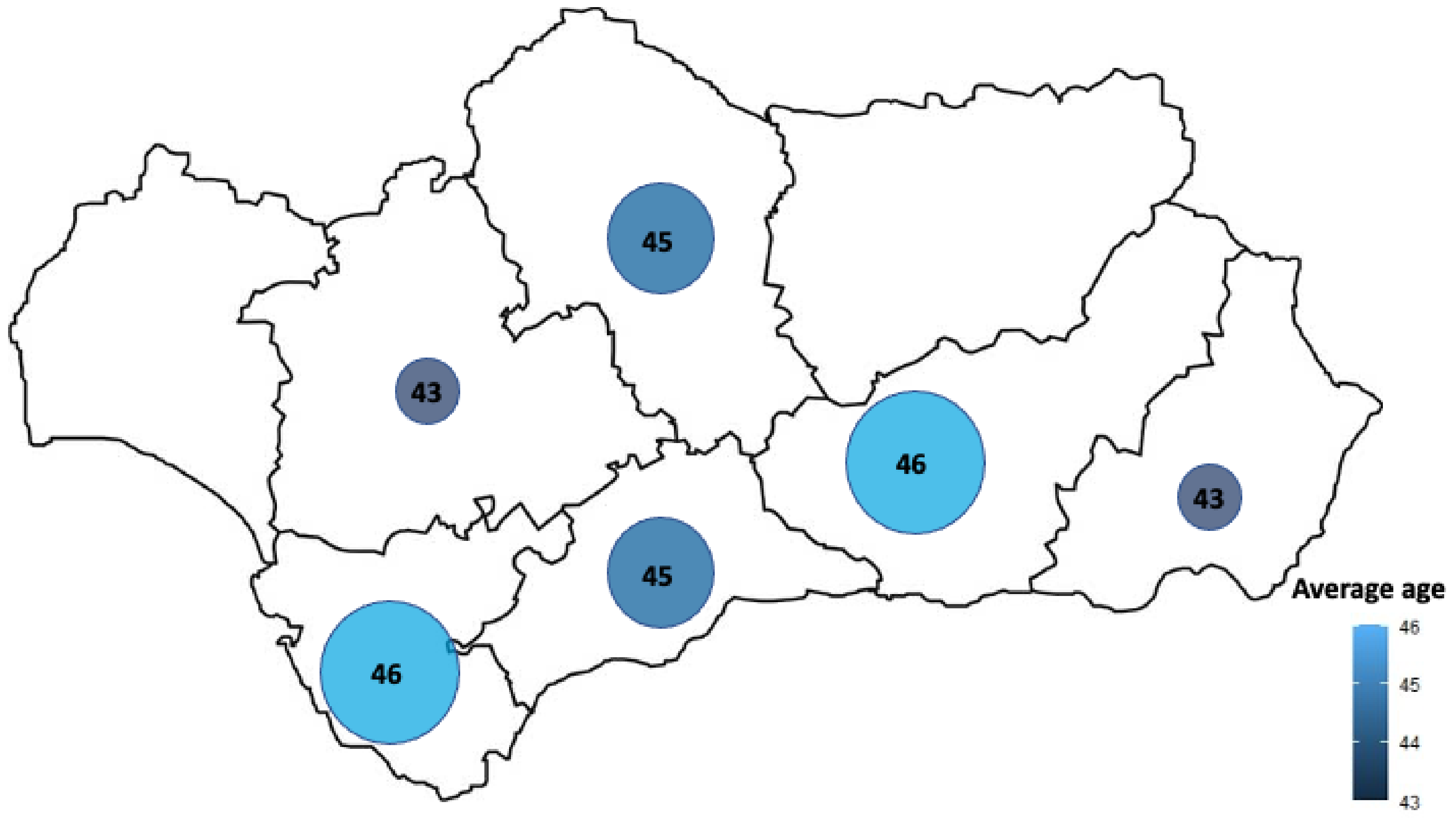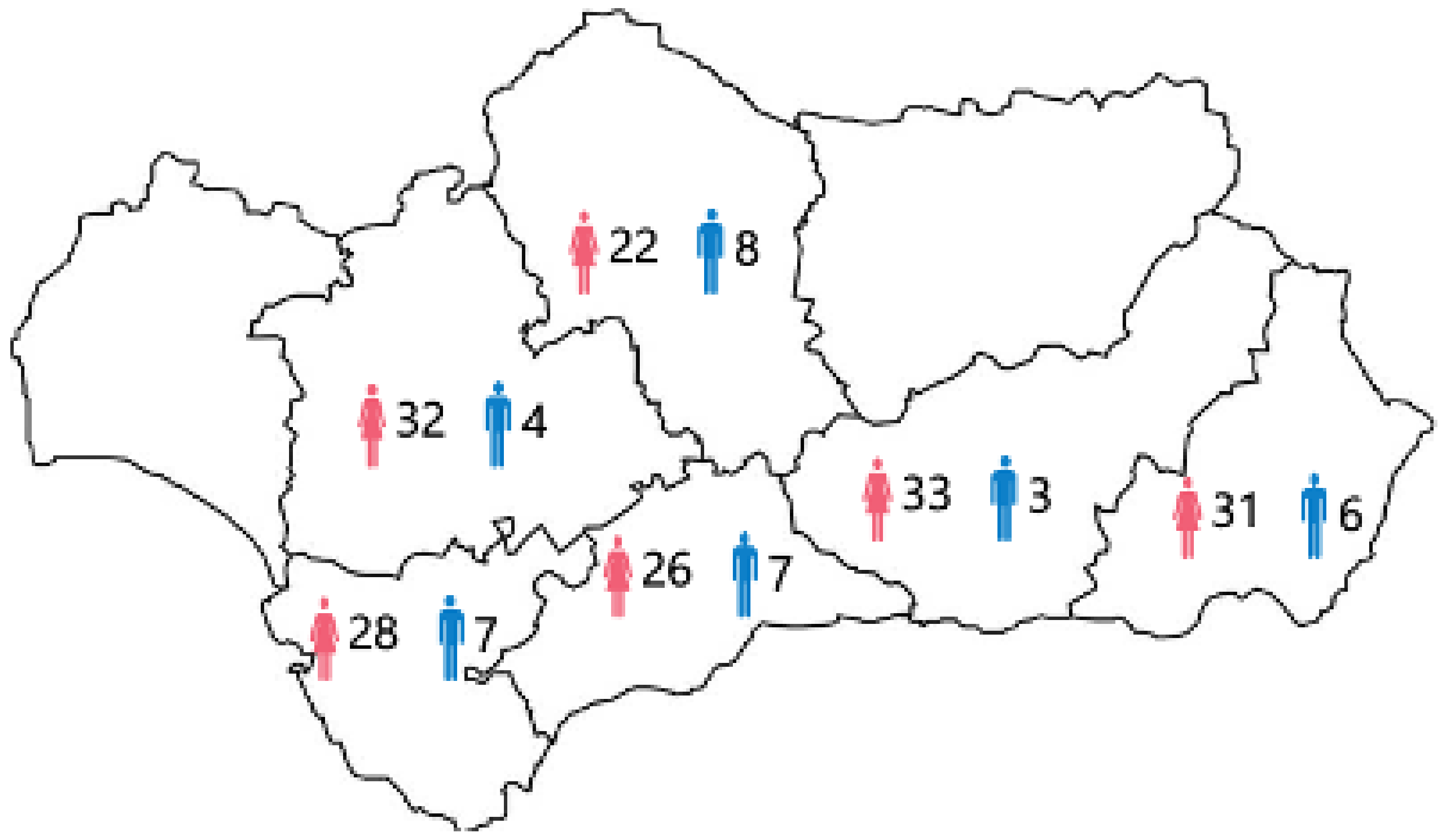3.1. Noise Results
The measurements were carried out in a flamenco dance class with 14 students corresponding to the subject of bolero dance. The class duration was about one hour, using a special kind of floor to tap dance. Moreover, the music was live with a flamenco singer and guitarist. For this flamenco class, the students used castanets. Thus, the results were given for these three scenarios: castanets, tap heels, and singer and guitarist; only castanets; and castanets and tapping.
Figure 2 shows the results for these three situations. In this figure, we can see that the use of castanets increases the high-frequency noise.
It should consider that measures realized for each combination of sound sources indicated before, are independent. That is, is not possible to compare exactly the values of each band in each sound source, but only the trends. Although the castanet player, or the dancer when tapping on the floor, try to make approximately the same sound, is impossible to be exact the same sound. Is for that, in
Figure 3 we can observe that in some frequency bands, the sound of castanets and tapping, for example, is above the sound of castanets, tapping, and singer.
In its turn, the tapping increases the low-frequency noise. The highest noise level is achieved when castanets, tapping, singers, and guitarists were together, reaching above 90 dB(A) in the 800 Hz one third band, and up to 95 dB(A) in the global level. This is a high sound level during 5 h throughout the day, and it is the same for all days per week. Not in all classes there is live music, in some there is audio equipment that is used, and the volume of music is established by each teacher in their classes. Some authors have found that this could have consequences in hearing loss [
26]. Following the results obtained in the survey explained in
Section 3.3, almost 20% of the participants had temporary auditory threshold shifts at 500 Hz, 2000 Hz, and 6000 Hz. These results have been ratified in this research, following the survey results. Moreover, the maximum value was 97 dB(A), and the minimum value achieved during the recorder time was below 54 dB(A). Measures was made following the RD 286/2006 [
38].
The
Figure 3 shows the one third of octave spectrum for separated noise sources. It is possible to observe how the main noise source is the tapping, especially at low frequencies. Besides, the LAeq (equivalent continuous sound pressure level) reaches is 102 dB (A) considering all noise sources (tapping, castanets, and singer) which is higher than the established one by RD 286/2006 [
38] (85 dB (A)).
Figure 4 shows the background noise measured in three different classroom and comparing it with
Figure 3, it is possible to see how the different is higher than 10 dB(A); thus, this could consider that the background noise is insignificant.
The specific loudness of Zwicker was also evaluated. As it is possible to observe in
Figure 5, when castanets, tapping, singer, and guitarist were together, the maximum value was reached (around 9.20 sone/bark). Notably, castanets, tapping, and singer sound (blue outline) is predominated as specific loudness Zwicker on the others sound sources.
3.3. Surveys Results
A total of 183 teachers responded to the survey. The city with a higher frequency of participants was Seville, with 20.7% (representing 38 teachers out of 183), followed by Granada (20.2%; 37 teachers out of 183), Cordoba (18.0%; 33 teachers out of 183), Malaga (15.3%; 28 teachers out of 183), Cadiz (14.2%; 26 teachers out of 183), and Almeria (11.5%; 21 teachers out of 183). The rate of response in Cordoba conservatory was 100% of the workers, while in Granada was 94.8% (being filled by 37 out 39), followed by Cadiz (74.3%; being 26 out of 35 teachers), Sevilla (around a 70% including professors and musicians answered the survey, being 38 out of 54), and, finally, Málaga and Almería which frequency was in 59.6% (being 28 out of 47) and 65.6% (21 teachers out of 32), respectively. The mean age of the survey respondents was around 45 years old, see
Figure 6.
Figure 7 shows the gender of dance teachers in the conservatories. It is possible to appreciate that the number of men is lower than women, this percentage being a decrease of 20%, and having significant differences between samples (
p < 0.05), although the sex was not linked to health issues (
p < 0.05).
The results of each survey indicated differences between each city for the normative regarding occupational safety (p < 0.01), the self-preservation plan (p < 0.01), the risk associated with the work (p < 0.001), and the center’s update of the occupational safety and health protocols (p < 0.001). There were not found differences between centers regarding the evaluation given to the working environment, the presence of health issues (injuries or discomfort and problems associated with noise), annual medical check-ups, or the type of contract (p > 0.05).
Besides, the presence of health problems or issues was found to be presented in 84.6% of the sample, being the mean of health problems set in 6.3 ± 4.6 95% CI (5.6–6.9). Moreover, the presence of health issues seemed was different in multiples variables according to the chi-test (
Table 2). The frequency of the factors showed how most participants had an indefinite contract (70.3%), considered that they knew the normative regarding occupational safety (45.1%), the self-protective code of the center (57.7%), and the risks associated with the work (73.1%). Moreover, the correlations indicated a link between having a health issue and having an indefinite contract (ρ = 0.657;
p < 0.001), not knowing the normative (ρ = 0.387;
p < 0.001), the self-protection plan (ρ = 0.356;
p < 0.001), and not knowing the risk associated to work (ρ = 0.465;
p < 0.001).
The participants’ health issues were also linked to their opinion regarding the prevention measures taken by the centers (
Table 3).
Table 3 showed how the perception of workers with health issues about the occupational safety and health (OSH) measures taken by the center (median = 2; IQR = 1), the training regarding OSH measures (median = 2; IQR = 2), the actualization (median = 2; IQR = 4), or medical check-ups (median = 2; IQR = 2.75) were never or sometimes carried out in the working environment.
Table 3 also indicated how there were significant differences between perceptions among the workers. Moreover, the correlations indicated how workers with health issues had a tendency to indicated that sometimes the OSH measures were applied (τ = −0.31;
p < 0.001), the training regarding OSH in working hours (τ = −0.41;
p < 0.001), the additional information (τ = −0.29;
p < 0.001), the actualization of the protocols (τ = −0. 344;
p < 0.001), and the annual medical check-ups (τ = −0.29;
p < 0.001).
The participants’ health issues were ultimately associated with their opinion regarding the evaluation of the medical check-ups and the working conditions, focusing on noise, thermal environment, and vibrations (
Table 4). The evaluation of workers with health issues regarding the medical check-ups and environmental conditions was unacceptable (median = 1; IQR = 1), although there were no significant differences between those participants with better opinion and worse opinion regarding the medical check-ups (
Table 4). The correlations indicated how workers, that considered they had no health issues, had a better opinion about the climatologic (ρ = 0.55;
p < 0.001) and thermal (ρ = 0.55;
p < 0.001) conditions, the air stream in classrooms (ρ = 0.43;
p < 0.001), the humidity (ρ = 0.2;
p < 0.05), the acoustic for communicating with the students (ρ = 0.39;
p < 0.001), noise levels (ρ = 0.43;
p < 0.001), and acoustic isolation in the classrooms (ρ = 0.34;
p < 0.001).
A multivariant analysis (R square = 0.56; sum of squares = 8.7; p-value < 0.001) showed that the presence of any health issue in this samples was linked to having an indefinite contract (p < 0.001), knowing the normative regarding occupational safety and health (p < 0.001), and the risk associated to work (p < 0.01), being the training about OSH scheduled during the working hours (p < 0.05), and the annual medical check-ups (p < 0.001).
The health issues were divided into injuries (being presented in 89.7%) and discomfort and problems associated with noise (being presented in 68.0%), being linked between each other (ρ = 0.45;
p < 0.001). The mean of motion injuries was higher (3.88 ± 2.7) per worker than the discomfort and problems linked to noise levels (2.7 ± 2.5).
Table 5 showed the injuries associated with ergonomic and repetitive motion during the dance classes. The injuries with the most incidences for all conservatories in Andalusia was muscle contracture. Moreover, cramps had a high incidence rate as injury among dance teachers and musicians. On the contrary, the fractures were the least frequent injuries for dance teachers. The conservatories with the highest rate of lesions were Cordoba and Granada. However, the percentages in Cadiz and Almeria showed the lowest rate of repetitive motion injuries. Additionally, no significant differences were found between injuries associated with the ergonomic and repetitive motion during the dance classes and the different cities (
p > 0.05).
The injuries associated to the ergonomic and repetitive motion was linked to the evaluation of the climatologic (ρ = 0.49; p < 0.001), thermal conditions (ρ = 0.52; p < 0.001), air stream (ρ = 0.42; p < 0.001), humidity (ρ = 0.23; p < 0.01), acoustic for communicating students (ρ = 0.38; p < 0.001), noise levels (ρ = 0.41; p < 0.001), and the isolation (ρ = 0.38; p < 0.001). Moreover, the injuries were also associated to having an indefinite contract (ρ = 0.52; p < 0.001), the normative of OSH in the center (ρ = 0.31; p < 0.001), the self-protection plan of the center (ρ = 0.21; p < 0.01) knowing the risks related to the work (ρ = 0.37; p < 0.001), and the frequency of training, additional information, or actualizations regarding OSH and medical check-ups (p < 0.001). The multivariant analysis (R square = 0.54; p-value < 0.001; with a constant of B = 0.81) showed that the presence of lesions or ergonomic problems due to motion was associated to having an indefinite contract (p < 0.001), knowing the risk associated to the work (p < 0.01), being the training about OSH scheduled during the working hours (p < 0.01), the actualization of protocols (p < 0.001), the annual medical check-ups (p < 0.001), the evaluation of air stream (p < 0.001), the acoustic for communicating with students (p < 0.001), and the noise levels in the classrooms (p < 0.001).
Regarding the discomfort and problems associated with noise during the classes,
Table 6 showed the annoyances for Andalusian’s different conservatories. The main problem associated with high noise is discomfort, vocal nodules, and edema or swellings. Deafness, irritability, and stress problems were also presented for all conservatories except Cadiz, where the percentage for these is slightly lower. However, sleep disturbances seem not to be a problem among the dance teachers, musicians, and singers as this has an average percentage of around 20%. Although, significant differences were found between its presence and the different cities (
p > 0.05).
The discomfort and problems associated to noise was linked to the evaluation of the climatologic (ρ = 0.64; p < 0.001), thermal conditions (ρ = 0.64; p < 0.001), air stream (ρ = 0.57; p < 0.001), humidity (ρ = 0.41; p <0.001), acoustic for communicating students (ρ = 0.50; p < 0.001), noise levels (ρ = 0.32; p < 0.001), and the isolation (ρ = 0.23; p < 0.01). Moreover, the discomfort and other health problems were also associated to having an indefinite contract (ρ = 0.73; p < 0.001), the normative of OSH in the center (ρ = 0.62; p < 0.001), the self-protection plan of the center (ρ = 0.17; p < 0.05) knowing the risks related to the work (ρ = 0.48; p < 0.001), and the frequency of additional information and actualizations regarding OSH (p < 0.001). The medical check-ups, the raining provided by the center and being such training schedule in the working hours were not linked to the presence of discomfort or health problems associated to noise (p > 0.001). The multivariant analysis (R square = 0.69; p-value < 0.001) showed that the presence of the discomfort or problems related to the noise were linked to having an indefinite contract (p < 0.001), having additional information regarding OSH in the centers (p < 0.05), the actualization of protocol regarding OSH (p > 0.01), the annual medical check-ups (p < 0.001), the evaluation of thermal conditions (p < 0.001), and the noise levels in the classrooms (p < 0.001).

